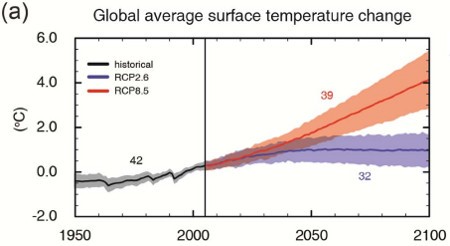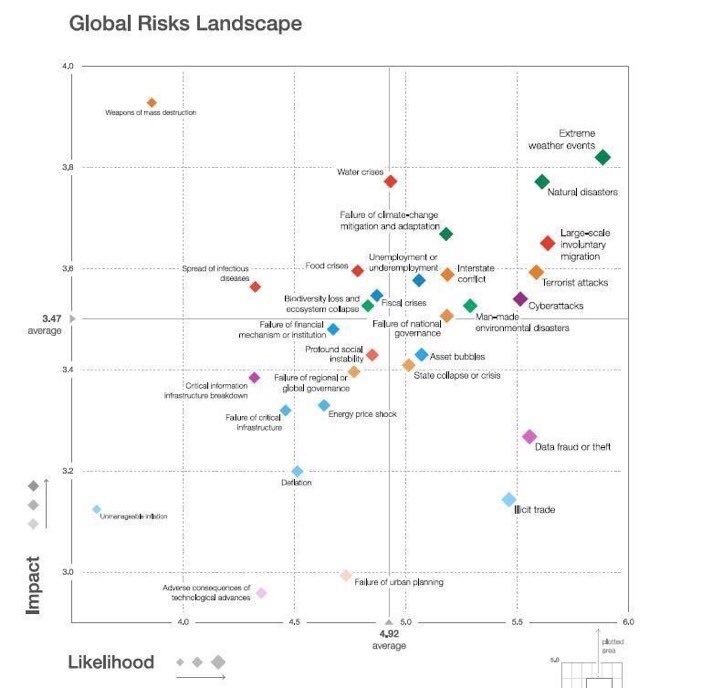Let’s not sugarcoat this post. Even if the entire planet went cold turkey getting off fossil fuels today, it may already be too late to prevent civilization as we know it from having to drastically change in order not enter a new dark age. One of the worst problems with carbon pollution is sea level rise. At around 405 parts per million carbon levels may already be too high to prevent catastrophic sea level rise well above three feet. Long after the start of the 22nd century the Earth will continue to warm. It is a fact that most of the world’s population resides in big cities along the coast. Huge coastal cities, such as London, New York, Bangalore, Miami, San Francisco, and New Orleans sooner or later must adapt and move inland or disappear from the map. The move inland will cause great stress to millions of people, although it is hoped that sea level will be slow enough for relatively smooth adaptation. The lower the ppm number of carbon in the atmosphere, the more time the world will have to mitigate and adapt to climate change. So, the big questions we will try to tackle in this article are how concentrated levels of carbon can get for civilization to continue in its current form to go on, and if concentrations are already too high, how long before stresses become too much before government begins to shatter.
I would love to present a handy, simplified table showing ppm levels with expected results, but the science remains too unclear. Without being too alarmist, the bottom line is that no one can make more than educated guesses as to how much carbon levels will rise to a peak before levelling off, or what the exact cause and effect ramifications will be, so briefly I will present some of the best present day, expert opinion on this subject. Before going further, we need to define a term. A “point of stabilization” would be sometime in the future when carbon levels measured in parts million rise to a certain maximum figure then slowly, with time, go down.
To start Bill Mckibben, who began 350.org, maintains that the level of carbon must drop back to 350 ppm to maintain a healthy climate. Pre-industrial levels were around 280 ppm. As shown in my last post, if anything, carbon levels in the atmosphere are increasing and not stabilizing or going down, so a future, “healthy climate” is just not going to be attained for many centuries to come. I would maintain that forecasts of a future climate need to be tailored around a target range of at least 450 ppm or higher starting from the current 405 ppm. This is simple math. At around the current annual rise of 3 ppm, 45 divided by 3 would give us only 15 more years to reign in carbon pollution just to keep levels at or below 450 ppm. If the rate falls to 2 ppm the number of years to stabilize at 450 ppm would be 22.5. Obviously, if sometime between now and the point of stabilization, the rate of increase falls below 2 or 1 ppm that would give mankind more time to stabilize levels around 450 ppm. I just don’t see how we can avoid a level of 450 ppm or higher, unless, God forbid, an unforeseen catastrophe such as a nuclear holocaust, happens to humanity.
Often these days the phrase “business as usual” is bandied about. Business as usual refers to the current rate of carbon emissions as well as other factors like world population increase. Perhaps one reason why there are so many skeptics is that climate science can get very technical with concepts not understood very well by the public, so I will be very methodical with this and future educational posts. We must be very careful not to “talk down” or appear to be arrogant when presenting information. The following is a simple chart I will use as an example, and there are many, guesstimating the future average temperature of the planet given business as usual scenarios and those in which carbon pollution is curtailed from IPCC (Intergovernmental Panel on Climate Change) estimates:

Back in 2000 it was hoped that carbon pollution would be curtailed giving an RCP2.6 result. RCP is the acronym for “Representative Concentrated Pathways” of carbon. To delve into what technically went into RCP2.6 please see this paper:
http://link.springer.com/article/10.1007%2Fs10584-011-0152-3
From Wikipedia: “Representative Concentration Pathways (RCPs) are four greenhouse gas concentration (not emissions) trajectories adopted by the IPCC for its fifth Assessment Report (AR5) in 2014. It supersedes Special Report on Emissions Scenarios (SRES) projections published in 2000.”
“The pathways are used for climate modeling and research. They describe four possible climate futures, all of which are considered possible depending on how much greenhouse gases are emitted in the years to come. The four RCPs, RCP2.6, RCP4.5, RCP6, and RCP8.5, are named after a possible range of radiative forcing values in the year 2100 relative to pre-industrial values (+2.6, +4.5, +6.0, and +8.5 W/m2, respectively).” W/m squared in physics is Watts per meter squared, or the amount of energy applied to one square meter of surface area.
Notice in figure (a) that warmth is curtailed to just below a one degree Celsius from 2000 rise in the planet’s temperature well before the year 2100 using RCP 2.6….a pipe dream given that the Earth’s temperature is already near that one degree Celsius warmer level as of 2016:

So, in the RCP8.5, or a more business as usual and house of horrors result, we get a rise of around 4 degrees Celsius by 2100. I would invite anyone to Google RCP8.5 to learn more about that nightmarish scenario. As far as RCP8.5, business as usual, concentrations of carbon in the atmosphere go, we can just do some more simple math to get a rough figure: Approximately 3 ppm per year times eighty more years added to 405 ppm would give us 645 ppm. On the other hand, I seriously doubt that industry will pump out enough CO2 to get to the 645 ppm figure, particularly after the horrors of climate change become very apparent by the middle part of this century. The following simple chart is the current best guess scenario of temperature projections by 2100. The chart is just a reflection of what we see in figure (a). We will delve into why the United Nations wants to keep average temperatures below 2.0 Celsius in a later post. AR5 just refers to the IPCC’s 5th assessment report in 2013:
| AR5 global warming increase (°C) projections | ||
| 2046-2065 | 2081-2100 | |
| Scenario | Mean and likely range | Mean and likely range |
| RCP2.6 | 1.0 (0.4 to 1.6) | 1.0 (0.3 to 1.7) |
| RCP4.5 | 1.4 (0.9 to 2.0) | 1.8 (1.1 to 2.6) |
| RCP6.0 | 1.3 (0.8 to 1.8) | 2.2 (1.4 to 3.1) |
| RCP8.5 | 2.0 (1.4 to 2.6) | 3.7 (2.6 to 4.8) |
Dr. Judith Curry, a highly-respected climate change skeptic formerly from Georgia Tech, paints a rosier picture, which is plausible and I hope will happen here:
https://judithcurry.com/2015/12/13/a-closer-look-at-scenario-rcp8-5/
Dr. Curry does not doubt that carbon pollution is causing planetary warming, just the rate and veracity of the effects of climate change.
And now on to an introduction of what is already a pressing problem in Miami and New Orleans. Again, I will try to relate ppm and temperature numbers with sea level rise. I will cite from a brand new report noted here: https://yournz.org/2017/02/09/global-and-regional-sea-level-rise-scenarios/
Quoting from the first paragraph of the introduction of the report: “Long-term sea level rise driven by global climate change presents clear and highly consequential risks to the United States over the coming decades and centuries. Today, millions of people in the United States already live in areas at risk of coastal flooding, with more moving to the coasts every year (Melillo et al., 2014). Rising seas will dramatically increase the vulnerability of this growing population, along with critical infrastructure related to transportation, energy, trade, military readiness, and coastal ecosystems and the supporting services they provide (Parris et al., 2012; Hall et al., 2016). One recent study estimates that 0.9 meters (m) of sea level rise would permanently inundate areas currently home to 2 million Americans; 1.8 meters would inundate areas currently home to 6 million Americans (Hauer et al., 2016).” Of note, the 2017 NOAA report has revised sea level rise estimates upward, which is not a good sign. At over 600 ppm RCP8.5 would be likely, and don’t forget that the seas won’t stop rising once the calendar hits the year 2100.
The following are two graphs from the report:


Notice in the second chart we see those RCP references. Again, I see no reason for the RCP2.6 scenario to verify given the rate of CO2 rise and the global West’s current political backlash towards mitigation.
So, on to a bigger question. How much climate stress need occur before world governments start to topple? We are already beginning to see climate change stress taxing some governments around the world. In the Middle East a strong link has been made to the Syrian conflict and climate change as reported by The New York Times. “Drawing one of the strongest links yet between global warming and human conflict, researchers said that an extreme drought in Syria between 2006 and 2009 was most likely due to climate change, and that the drought was a factor in the violent uprising that began there in 2011.”
Please see the full article here: https://www.nytimes.com/2015/03/03/science/earth/study-links-syria-conflict-to-drought-caused-by-climate-change.html
The Pentagon takes climate change very seriously. The following Newsweek article from 2014 let the public know of a report outlining what our military might do in case climate change related stress to society got out of hand: http://www.newsweek.com/pentagon-report-us-military-considers-climate-change-immediate-threat-could-277155
Quoting from the article: “The report is a “roadmap” of the Department’s future needs and actions to effectively respond to climate change, including anticipating that climate change may require more frequent military intervention within the country to respond to natural disasters, as well as internationally to respond to “extremist ideologies” that may arise in regions where governments are destabilized due to climate-related stressors.”
In 2017 per The United Nations “Concerned about risks to your #security? #Climatechange + lack of adequate #ClimateAction top the chart, according to @wefpic.twitter.com/OeTubPgkPL”

We will look at stress related climate issues on future posts, including severe flooding, droughts, heat waves, and hurricanes.
So how much carbon pollution is too much? Unfortunately any more than the current level of 405 ppm is way to much. The amount it would take to topple civilization remains an open ended, muddy question.
We will look at early 2017 temperature trends on my next post.
The Climate Guy